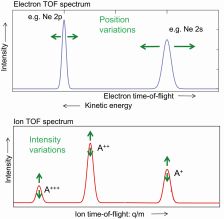The OPIS device at FLASH2 comprises four electron and one ion time-to-flight spectrometers. The electron spectrometers are arranged in pairs of oppsing devices in order to cancel-out the influence of the photon beam position on the arrival time of the electrons. The picture shows the OPIS device mounted in the photon diagnostics section in the FLASH2 tunnel.
Wavelength measurements with the online photoionization spectrometer (OPIS) are based on photoionization processes of gas targets such as rare gases or small molecules like N2 or O2. Since binding energies and photoionization cross sections are precisely known from literature for a large variety of gases, they can be used as a basis for wavelength determination for the full wavelength range of FLASH.
An ion spectrometer is used to measure the intensities of different charge states of the created photo-ions. Since the partial cross sections of the charge states evolve differently with increasing photon energy, the ratios of their corresponding intensities are a unique measure of the photon wavelength in a certain wavelength interval. The ion spectrometer has two major advantages: The signal intensity is high since the extraction fields collect all ions created by the radiation, and it is insensitive against beam position changes.
In electron time-of-flight spectra, the arrival times of the photo-electrons directly reflect their kinetic energy. The electron binding energies of the orbitals from which the photo-electrons are emitted are the only information needed for wavelength determination. This is the main advantage compared to the ion method described above. In addition, higher harmonics content and the number of FEL modes can, in principle, be deduced as well. On the other hand, the electron signal intensity is lower compared to the ion signals due to limited acceptance angles, and it is sensitive to external magnetic and electric fields.
Electrons emitted in Auger processes have a constant kinetic energy independent from the photon energy. Photoionization resonances give rise to signatures in the electron spectra, such as increased satellite intensities, as well as in the ion yield. Analysis of such features
provides a self-calibration capability during the commissioning phase and the potential to confirm – under certain conditions – the
calibration during the actual wavelength measurement.
Applying a low target gas pressure in the range of 10-7 hPa, essentially 100% of the photon intensity is transported to the user experiment. The electron and ion signals from the MCP-detectors of the spectrometers are recorded with fast ADCs, enabling in principle single-shot FEL wavelength monitoring. Traces of full bunch trains are stored to the FLASH DAQ systems for further analysis, if requested. These advantages make OPIS a promising complement to the existing grating spectrometers.
After comprehensive studies with an OPIS prototype at FLASH1, an improved version of the device has been installed in the photon diagnostic section at FLASH2 to serve as the primary wavelength monitoring tool for machine wavelength tuning as well as user operation.
CONTACT
|
|
|
|
References:
[1] P. Juranic et al., Using I-TOF spectrometry to measure photon energies at FELs, J. Inst. 4, P09011 (2009); http://dx.doi.org/10.1088/1748-0221/4/09/P09011
[2] M. Wellhöfer et al., Photoelectron spectroscopy as non-invasive method to monitor SASE-FEL radiation, JINST 3, P02003 (2008);
http://dx.doi.org/10.1088/1748-0221/3/02/P02003
[3] M. Braune et al., A non-invasive online photoionization spectrometer for FLASH, Journal of Synchrotron Radiation 23, Part 1,10-20 (2016);
https://doi.org/10.1107/S1600577515022675
[4] M. Braune et al., Non-invasive online wavelength measurements at FLASH2 and present benchmark, Journal of Synchrotron Radiation 25, Part 1,3-15 (2018);
https://doi.org/10.1107/S1600577517013893









